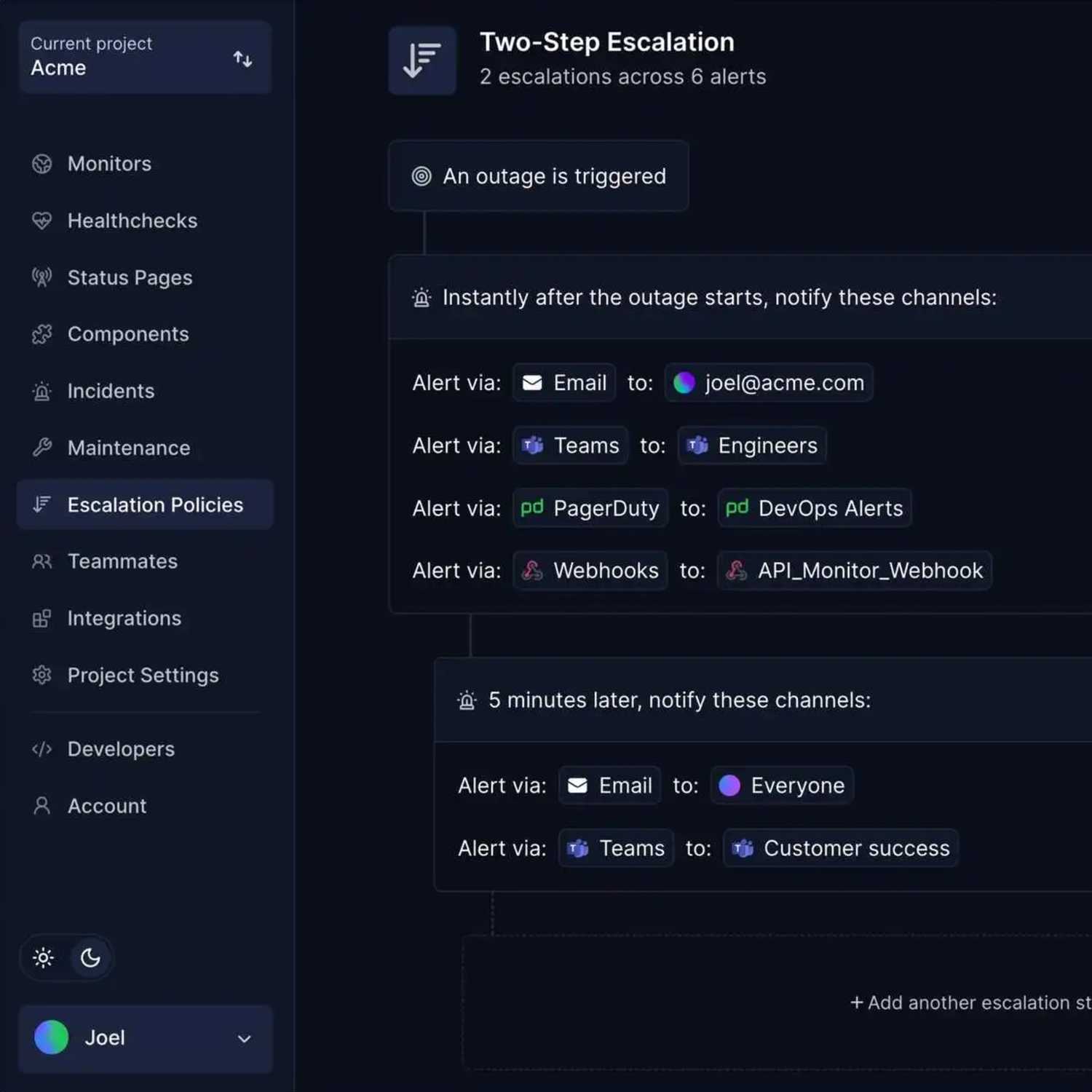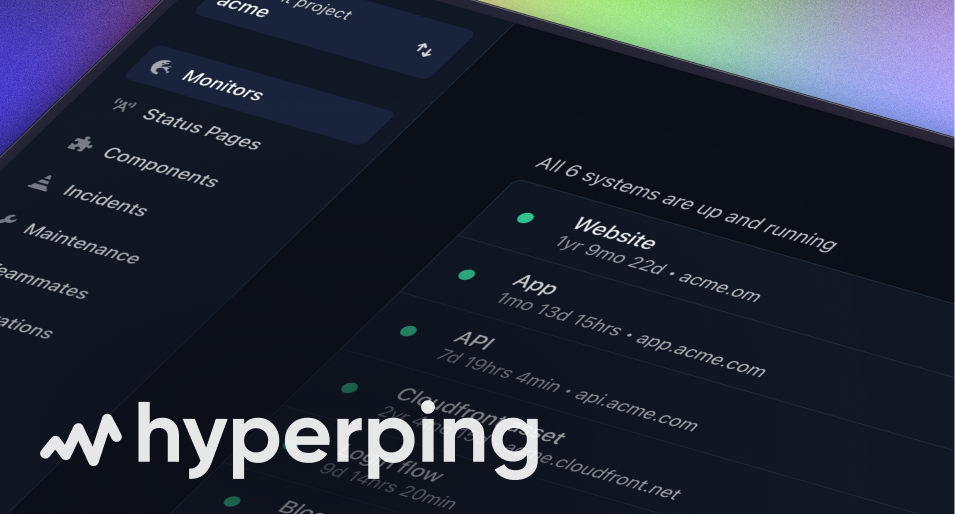Nowadays, almost half of traditional small businesses (and nearly 2/3rds of small tech companies in particular) employ cloud infrastructure or hosting services, and for good reasons.
As a reliable uptime monitoring service, we at Hyperping fully understand the importance of monitoring your assets to keep track of functionality and performance.
Monitoring every aspect of your cloud infrastructure requires a lot of different tools. And the space is crowded!
So instead of listing a bunch of tools, we decided to analyze 64 tools and give you what we think is the best for each category.
Cloud monitoring isn’t simple. It requires multiple tools.
Cloud monitoring isn't one-size-fits-all.
Like a security system for your home, you need different tools watching different aspects of your cloud infrastructure.
Here's what each type does for you:
- Uptime monitoring — Watches your websites and services 24/7 to confirm they're available. Tools like Hyperping check every 30 seconds and alert you instantly when something's down. Essential for maintaining customer trust and meeting SLAs.
- Server monitoring — Tracks the health of your servers - CPU usage, memory, disk space, and network traffic. Tools spot problems before they affect users, like catching a failing hard drive before it crashes.
- Network monitoring — Watches data moving through your systems. Tools track bandwidth usage, spot bottlenecks, and identify connection problems. Think of it as traffic control for your cloud.
- Infrastructure monitoring — Watches your entire cloud setup - servers, databases, storage, and networks. Tools track how all these pieces work together, helping you spot problems that affect multiple systems. Like having a bird's-eye view of your whole operation.
- Security monitoring — Guards against threats and ensures compliance. Tools continuously scan for vulnerabilities, suspicious activity, and configuration mistakes that could let attackers in.
- Cost monitoring — Tracks your cloud spending and spots waste. Tools help teams understand exactly where their money goes and why bills keep growing. Essential as cloud services multiply.
Each type serves a specific purpose, and most organizations need several kinds working together.
Start with the basics (uptime monitoring) and add others as your needs grow. The goal isn't to use every type, but to have the right coverage for your specific systems.
Criteria to choose the right cloud monitoring tools
Choosing the right monitoring tool is like picking a security system for your home.
You need the right mix of features to protect what matters most.
Here's what to consider:
- Reliability — Your monitoring must be more reliable than the systems it watches. Look for tools with proven uptime, global check locations, and transparent status reporting. When monitoring fails, you're flying blind.
- Simple setup — Good tools work quickly without complex configuration. You want clear documentation, an intuitive interface, and the ability to start monitoring in minutes, not days.
- Smart alerts — Notifications should help, not overwhelm. The best tools let you customize triggers, connect to your existing workflow tools, and group related issues to prevent alert fatigue.
- Integration ready — Your monitoring should play nice with other tools. Look for standard integrations, webhook support, and open APIs. The ability to connect with your existing stack saves time and reduces complexity.
- Fair pricing — Quality monitoring shouldn't break the bank. Choose tools with transparent pricing, scalable plans, and no hidden costs. Your monitoring budget should match the value of what you're protecting.
- Clear reporting — Data should tell a story. Good tools provide easy-to-read dashboards, useful historical data, and shareable reports. When something breaks, you need answers fast.
- Responsive support — Problems don't wait for business hours. Pick a provider that offers reliable support through your preferred channels. Quick help during incidents can make or break your response time.
The best tool isn't always the one with the most features.
It's the one that solves your specific problems without adding unnecessary complexity to your stack.
Summary: our top cloud monitoring tools for 2025
After analyzing 64 tools, here are our top picks across different monitoring categories:
| Name | Best for… | Main pros | Free? | Price |
|---|---|---|---|---|
| Hyperping | Uptime monitoring & status pages | • 30-second checks • Unlimited status pages • Voice call alerts | Yes | Starts at $12/month for 15 monitors & 1 status page |
| Datadog | Server monitoring | • Complete infrastructure visibility • 500+ integrations • Strong automation | Yes | Custom pricing based on hosts |
| SolarWinds | Network monitoring | • Deep packet inspection • Automatic network mapping • Visual topology maps | No | Custom enterprise pricing |
| AWS CloudWatch | Infrastructure monitoring | • Automatic AWS integration • Self-building dashboards • Cross-account monitoring | Yes | Pay-per-use model |
| Wiz | Security monitoring | • Live security scanning • Multi-cloud support • Automatic compliance checks | No | Custom enterprise pricing |
| CloudZero | Cost monitoring | • Cost per customer tracking • Feature-level spending • Automatic resource grouping • Future expense prediction | No | Custom pricing |
Each tool excels in its specific category, and your choice should depend on your primary monitoring needs.
For most teams, starting with basic uptime monitoring (like Hyperping) and gradually adding specialized tools as needs grow is the most practical approach.
Best uptime monitoring tool: Hyperping

Your website just went down. Each offline minute costs you money and leaves customers frustrated.
Hyperping spots problems before they affect your business. Like a watchdog, it checks your services every 30 seconds and alerts you instantly when something breaks.
Key features
- 30-second check frequency
- Global monitoring locations
- SSL certificate tracking
- Port and cron job checks
- Synthetic monitoring
- Status pages
- Voice call alerts
- EU-based servers
Pros
- Single price — no hidden fees
- Quick setup
- Unlimited status pages
- Voice call alerts included
- Code-based testing
- Clean interface
Cons
- Basic reporting features
- Limited free plan
- Fewer integrations than alternatives
Why it's the best
We compared Hyperping with Better Stack, Uptime, and other monitoring tools. At the end, they have similar features and the decision comes down to the price.
Better Stack pricing:
- $21 per 50 monitors
- $29 per user
- $12 per status page
Hyperping gives you more for $74:
- 100 monitors
- 6 team members
- Unlimited status pages
Hyperping delivers reliable monitoring without complexity — powerful enough to catch issues, simple enough to use daily.
Compare Hyperping with other uptime monitoring tools
Best server monitoring tool: Datadog

Datadog watches everything happening in your servers - from basic CPU stats to complex container metrics. Like having x-ray vision, you see inside every server, container, and service running in your cloud.
Key features
Datadog includes essential server monitoring tools:
- Real-time tracking of CPU, memory, disk space, and network
- Built-in support for Docker and Kubernetes
- Custom metrics for specific needs
- Automatic discovery of new servers
- Over 500 integrations with other tools
- Machine learning-powered alerts
Pros
- Complete infrastructure visibility
- Clear, useful dashboards
- Strong automation capabilities
- Extensive integration options
- Solid documentation and support
Cons
- Expensive for larger deployments
- Complex initial setup
- Steep learning curve
- Resource-heavy agent
Why it's the best
We compared Datadog against New Relic, Dynatrace, and other top monitoring tools. Yes, Datadog is expensive. But in that category, they're all pretty expensive.
Datadog stands out in several areas:
- Better connections — While others struggle with certain integrations, Datadog connects smoothly to almost any service.
- Clearer dashboards — You'll find the data you need without advanced technical knowledge.
- Superior container support — Docker and Kubernetes monitoring works naturally, unlike clunky add-ons from competitors.
Best virtual network monitoring tool: SolarWinds

SolarWinds Network Performance Monitor spots network problems instantly. Like a traffic controller, it shows exactly where bottlenecks form and packets disappear.
Key features
- Deep packet inspection
- Automatic network mapping
- Hop-by-hop analysis
- Quality monitoring
- Multi-cloud support
- Visual topology maps
- Configuration tracking
- Smart alerting system
Pros
- Complete network visibility
- Fast problem detection
- Universal compatibility
- Rich historical data
- Scales with complexity
- Clear connection mapping
Cons
- Premium pricing
- Complex setup process
- Heavy resource usage
- Steep learning curve
- Windows-focused design
Why it's the best
We compared SolarWinds against ManageEngine, PRTG, and other network monitoring tools. While each tool has strengths, SolarWinds stands out in several ways:
- Better visualization — SolarWinds creates readable maps of your network topology, not just raw numbers
- Deeper analysis — NetPath tracks issues hop-by-hop, a feature most competitors lack
- Stronger integration — Handles both cloud and on-premise networks seamlessly
- More automation — Discovers and maps network changes without manual input
Complex virtual networks need powerful monitoring. SolarWinds gives teams the clarity and control to maintain reliable connections across their infrastructure.
Best cloud infrastructure monitoring tool: AWS CloudWatch

Running dozens of cloud services across multiple regions creates a monitoring challenge. CloudWatch solves this by connecting to every part of your AWS infrastructure, giving you a clear view of all your systems from one dashboard.
Key features
- Automatic AWS service integration
- Custom metric tracking
- Self-building dashboards
- Container insights
- Log analysis
- Pattern detection
- Cross-account monitoring
- Cost optimization suggestions
- Smart alert combinations
- API access
Pros
- Seamless AWS integration
- Single dashboard view
- Automatic resource discovery
- Built-in visualizations
- Predictive alerts
- Usage-based pricing
- Robust API
- Strong security
Cons
- Complex pricing
- High learning curve
- Limited non-AWS support
- Basic visualizations
- Scales expensive
- Requires AWS expertise
Why it's the best
We compared CloudWatch with Azure Monitor, Google Cloud Operations, and similar tools. CloudWatch stands out for several reasons:
- Natural integration — CloudWatch automatically discovers AWS resources while others need manual setup
- Complete visibility — Monitor metrics, logs, and traces in one tool
- Fair pricing — Pay for actual usage instead of flat rates
- Regular updates — AWS's market position means CloudWatch evolves faster than alternatives
CloudWatch fits AWS users perfectly. While Datadog and others support multiple clouds, they can't match CloudWatch's AWS integration depth or cost-effectiveness.
Best security and compliance monitoring tool: Wiz

Cloud security breaches cost millions and destroy customer trust. Wiz spots and fixes security gaps before attackers find them, scanning your infrastructure continuously for vulnerabilities and compliance issues.
Key features
- Live security scanning
- Automatic compliance checks
- Support for AWS, Azure, and Google Cloud
- Configuration monitoring
- Identity tracking
- Vulnerability detection
- Asset discovery
- Fix automation
- Simple reporting
- Risk scoring
Pros
- Complete visibility
- Clear risk scores
- Automatic resource discovery
- Built-in compliance frameworks
- Fast setup
- Direct fix instructions
- Strong integrations
- Regular threat updates
Cons
- Premium pricing
- Complex initial setup
- Alert overload possible
- Requires security expertise
- Limited customization
Why it's the best
We compared Wiz against Orca Security, LaceWork, and other security tools. Wiz stands out in several ways:
- Deeper coverage — Wiz analyzes both infrastructure and applications, catching issues others miss.
- Smart prioritization — Instead of endless alerts, Wiz highlights what needs immediate attention.
- Better automation — Discovers and checks resources automatically, while competitors need manual setup.
- Quick deployment — No agents required — just connect to your cloud accounts.
For teams handling sensitive data or facing strict compliance rules, Wiz delivers comprehensive protection without complexity. While more expensive than basic security tools, its thorough protection and ease of use justify the cost.
Best cloud cost monitoring tool: CloudZero

Cloud bills can be a mess. CloudZero turns confusing AWS charges into clear, actionable data that helps you spend smarter.
Key features
- Cost per customer
- Feature spending
- Money leaks
- Future expenses
- Team budgets
- Multi-cloud costs
- Engineering metrics
- Resource groups
- Saving options
- Cost alerts
Pros
- Links costs to business results
- Shows spending by feature
- Groups resources automatically
- Built for engineers
- Predicts expenses
- No manual tags needed
- Quick setup
- Regular saving tips
Cons
- Higher price point
- Complex initial setup
- Limited historical data
- Requires cloud expertise
- Some manual configuration
Why it's the best
We compared CloudZero with AWS Cost Explorer, ProsperOps, and other cost tools. CloudZero stands out because:
- Business context — Raw numbers become meaningful insights about your operations
- Smart grouping — Automatically organizes costs while others need manual tagging
- Engineer-friendly — Presents data in ways developers understand and use
- Early warnings — Identifies cost problems before they grow into budget disasters
Conclusion
Monitoring your systems shouldn't feel like rocket science.
We explored how cloud monitoring helps teams catch problems early, maintain uptime, and communicate clearly with customers.
Simple tools that match your needs will do more for your reliability than complex solutions you'll never fully use.
Want to improve your monitoring? Here's your action plan:
- 1 Check your current setup for gaps — which critical systems aren't being watched?
- 2 Add uptime monitoring to your most important endpoint (this takes 5 minutes and pays off immediately)
- 3 Set clear alert rules and response steps for your team
- 4 Launch a status page to give customers the transparency they deserve
Cloud infrastructure grows more complex daily, and solid monitoring becomes more valuable with each new service you add.
Hyperping helps teams like yours maintain reliable systems and keep customers informed without the complexity of traditional solutions.
Start small today — monitor just one endpoint. You'll build confidence and momentum from there and be able to start using complementary and more complex tools.
Frequently Asked Questions about cloud monitoring tools
What are the best cloud monitoring tools in 2025?
The best tool depends on your specific needs. Here are our top picks by category:
- Hyperping - Best for uptime monitoring and status pages
- Datadog - Best for server monitoring
- SolarWinds - Best for virtual network monitoring
- AWS CloudWatch - Best for cloud infrastructure monitoring
- Wiz - Best for security and compliance monitoring
- CloudZero - Best for cloud cost monitoring
Each tool excels in different areas:
- Hyperping keeps things simple with reliable uptime checks and clear status pages
- Datadog gives complete visibility into your servers and containers
- SolarWinds masters network performance tracking
- AWS CloudWatch naturally fits AWS environments
- Wiz protects against security threats and compliance issues
- CloudZero helps control cloud spending
Pick the tool that matches your main monitoring challenge rather than trying to find one that does everything.
How much do cloud monitoring tools cost?
Most tools follow this pricing pattern:
- Basic monitoring: $20-50/month
- Professional features: $100-300/month
- Enterprise solutions: $500+/month
What affects the price? Usually it's:
- How many things you monitor
- How long you keep the data
- Which features you need
- How many team members use it
What is cloud infrastructure monitoring?
Think of it as keeping an eye on everything in your cloud setup:
- Your servers and virtual machines
- All your databases
- Storage systems
- Network pieces
- Container apps like Docker
It's like having security cameras for your cloud - you see when something's not right.
Is cloud monitoring the same as application monitoring?
Nope — they're different things:
Cloud monitoring watches your infrastructure — like making sure your house's foundation is solid.
Application monitoring tracks your software — like making sure everything inside the house works well.
Some tools do both, but they serve different purposes.
What metrics should I monitor in cloud computing?
Focus on these key numbers:
- How much CPU you're using
- Memory usage
- Available disk space
- Network speed
- How fast things respond
- Error counts
- What you're spending
- Security stats
What are the key performance indicators for cloud services?
Here's what matters most:
- Uptime (shoot for 99.9% or better)
- Speed (under 200ms is good)
- Errors (keep them under 1%)
- Resource use (stay under 80%)
- Cost per service
- How happy users are
How often should you monitor cloud performance?
It depends on how critical the service is:
- Super important stuff: Every 30-60 seconds
- Regular services: Every 5 minutes
- Less critical things: Every 15-30 minutes
- Costs: Once a day
- Performance trends: Every hour
How do you measure cloud service uptime?
Keep track with:
- Regular health checks
- Response time monitoring
- Error counting
- SLA tracking
- Automated tests
- Status page updates
What is a good cloud uptime percentage?
Here's what different uptime numbers mean:
- 99.9% = Good (8.76 hours down per year)
- 99.95% = Better (4.38 hours down per year)
- 99.99% = Great (52.6 minutes down per year)
- 99.999% = Excellent (5.26 minutes down per year)
Pick the level that matches your needs and budget — higher uptime costs more to maintain.
Check out our free calculators: Four nines, Three nines, Four nines, Nine nines, SLA calculator, Downtime calculator, Uptime calculator.




